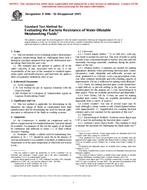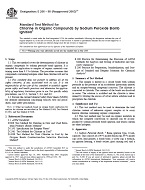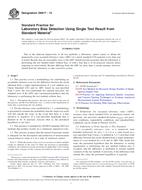1.1 This test method covers the determination of the dynamic elastic properties of advanced ceramics. Specimens of these materials possess specific mechanical resonant frequencies that are determined by the elastic modulus, mass, and geometry of the test specimen. Therefore, the dynamic elastic properties of a material can be computed if the geometry, mass, and mechanical resonant frequencies of a suitable test specimen of that material can be measured. Dynamic Young’s modulus is determined using the resonant frequency in the flexural mode of vibration. The dynamic shear modulus, or modulus of rigidity, is found using torsional resonant vibrations. Dynamic Young’s modulus and dynamic shear modulus are used to compute Poisson’s ratio.
1.2 This test method measures the resonant frequencies of test specimens of suitable geometry by mechanically exciting them at continuously variable frequencies. Mechanical excitation of the bars is provided through the use of a transducer that transforms a cyclic electrical signal into a cyclic mechanical force on the specimen. A second transducer senses the resulting mechanical vibrations of the specimen and transforms them into an electrical signal. The amplitude and frequency of the signal are measured by an oscilloscope or other means to detect resonant vibration in the desired mode. The resonant frequencies, dimensions, and mass of the specimen are used to calculate dynamic Young’s modulus and dynamic shear modulus. (See Fig. 1)
1.3 This test method is specifically appropriate for advanced ceramics that are elastic, homogeneous, and isotropic (3). Advanced ceramics of a composite character (particulate, whisker, or fiber reinforced) may be tested by this test method with the understanding that the character (volume fraction, size, morphology, distribution, orientation, elastic properties, and interfacial bonding) of the reinforcement in the test specimen will have a direct effect on the elastic properties. These reinforcement effects must be considered in interpreting the test results for composites. This test method is not satisfactory for specimens that have cracks or voids that are major discontinuities in the specimen. Neither is the test method satisfactory when these materials cannot be fabricated in a uniform rectangular or circular cross section.
1.4 A high-temperature furnace and cryogenic cabinet are described for measuring the dynamic elastic moduli as a function of temperature from −195 to 1200°C.
1.5 Modification of this test method for use in quality control is possible. A range of acceptable resonant frequencies is determined for a specimen with a particular geometry and mass. Any specimen with a frequency response falling outside this frequency range is rejected. The actual modulus of each specimen need not be determined as long as the limits of the selected frequency range are known to include the resonant frequency that the specimen must possess if its geometry and mass are within specified tolerances.
1.6 The procedures in this test method are, where possible, consistent with the procedures of Test Methods C623, C747, and C848. The tables of these test methods have been replaced by the actual formulas from the original references. With the advent of computers and sophisticated hand calculators, the actual formulas can be easily used and provide greater accuracy than factor tables.
1.7 The values stated in SI units are to be regarded as the standard. The values given in parentheses are for information only.
1.8 This standard does not purport to address all of the safety concerns, if any, associated with its use. It is the responsibility of the user of this standard to establish appropriate safety and health practices and determine the applicability of regulatory limitations prior to use.
Product Details
- Published:
- 11/04/2009
- Number of Pages:
- 11
- File Size:
- 1 file , 190 KB


